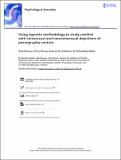| dc.contributor.author | Dawson, Kate | |
| dc.contributor.author | Noone, Chris | |
| dc.contributor.author | Nic Gabhainn, Saoirse | |
| dc.contributor.author | MacNeela, Padraig | |
| dc.date.accessioned | 2020-07-08T08:51:36Z | |
| dc.date.issued | 2020-05-18 | |
| dc.identifier.citation | Dawson, Kate, Noone, Chris, Nic Gabhainn, Saoirse, & MacNeela, Padraig. (2020). Using vignette methodology to study comfort with consensual and nonconsensual depictions of pornography content. Psychology & Sexuality, 4(2). doi:10.1080/19419899.2020.1769159 | en_IE |
| dc.identifier.issn | 1941-9902 | |
| dc.identifier.uri | http://hdl.handle.net/10379/16058 | |
| dc.description.abstract | Spanking, whipping, and choking are examples of aggressive behaviours that can be performed in consensual sexual encounters. However, within the pornography research literature, such behaviours are often perceived as being nonconsensual, categorized as “violent,” and argued to predict sexual aggression. Viewing nonconsensual pornography may be associated with negative attitudes toward consent; however, viewing consensual pornography that features typically violent behavior may not. In this study, we sought to more clearly distinguish between consensual and nonconsensual pornography depictions by using vignettes to examine individuals’ consent attitudes in relation to these pornographic vignettes. We also sought to assess the hypothesis that more frequent pornography engagement will be associated with greater comfort with the nonconsensual vignettes. A series of pornography vignettes were developed by the researchers and categorized by a group of sexual consent experts as “consensual” or “nonconsensual” vignettes during a three-round Delphi study. The finalized vignettes were administered to a convenience sample of Irish university students (n = 1,121), who also answered questions regarding their attitudes toward consent and frequency of pornography engagement. More frequent pornography engagement was not associated with greater comfort with the nonconsensual vignettes. Greater comfort with the nonconsensual pornography vignettes was negatively associated with attitudes toward establishing consent and the endorsement of sexual consent norms. | en_IE |
| dc.format | application/pdf | en_IE |
| dc.language.iso | en | en_IE |
| dc.publisher | Taylor & Francis (Routledge) | en_IE |
| dc.relation.ispartof | Psychology and Sexuality | en |
| dc.rights | Attribution-NonCommercial-NoDerivs 3.0 Ireland | |
| dc.rights.uri | https://creativecommons.org/licenses/by-nc-nd/3.0/ie/ | |
| dc.subject | Consent | en_IE |
| dc.subject | Pornography | en_IE |
| dc.subject | Vignette | en_IE |
| dc.subject | College Students | en_IE |
| dc.subject | Quantitative | en_IE |
| dc.title | Using vignette methodology to study comfort with consensual and nonconsensual depictions of pornography content | en_IE |
| dc.type | Article | en_IE |
| dc.date.updated | 2020-06-30T15:28:01Z | |
| dc.identifier.doi | 10.1080/19419899.2020.1769159 | |
| dc.local.publishedsource | https://doi.org/10.1080/19419899.2020.1769159 | en_IE |
| dc.description.peer-reviewed | peer-reviewed | |
| dc.description.embargo | 2021-05-18 | |
| dc.internal.rssid | 21651945 | |
| dc.local.contact | Saoirse Nic Gabhainn, Dept. Of Health Promotion, Aras Moyola, Nui Galway. 3093 Email: saoirse.nicgabhainn@nuigalway.ie | |
| dc.local.copyrightchecked | Yes | |
| dc.local.version | PUBLISHED | |
| nui.item.downloads | 223 | |


